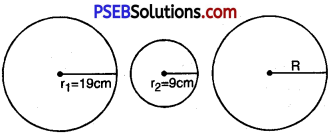Punjab State Board PSEB 10th Class Maths Book Solutions Chapter 12 Areas Related to Circles Ex 12.1 Textbook Exercise Questions and Answers.
PSEB Solutions for Class 10 Maths Chapter 12 Areas Related to Circles Ex 12.1
Question 1.
The radii of two circles are 19 cm and 9 cm respectively. Find the radius of the circle which has circumference equal to the sum of the circumferences of the two circles.
Solution:

Radius of first circle (r1) = 19 cm
Radius of second circle (r2) = 9 cm
Let radius of third circle be R cm
According to condition
circumference of first circle + circumference of second circle = circumference of third circle
2πr1 + 2πr2 = 2πR
2π (r1 + r2] = 2πR
19 + 9 = R
∴ R = 28
∴ Radius of third circle (R) = 28 cm.
![]()
Question 2.
The Radii of two circles are 8 cm and 6 cm respectively. Find radius of circle which is having area equal to sum of the area of two circles.
Solution:
Radius of first circle (r1) = 8 cm
Radius of second circle (r2) = 6 cm
Let radius of third circle be R cm
According to question
Area of third circle = Area of first circle + Area of second circle
πR2 = πr12 + πr22
πR2 = π[r12 + r22]
R2 = (8)2 + (6)2
R = \(\sqrt{64+36}=\sqrt{100}\)
R = 10 cm
∴ Radius of required circle (R) = 10 cm.
![]()
Question 3.
Fig. depicts an archery target marLed with its five scoring areas from the centre ‘utwards as Gold, Red, Blue, Black and White. The diameter of the region representing Gold score ¡s 21 cm and each of the other bands is 10.5 cm wide. Find the area of each of the five scoring regions.

Solution:
Diameter of Gold region = 21 cm
Radius of Gold region (R1) = 10.5 cm
∴ Area of gold region = πR12
= \(\frac{22}{7} \times \frac{21}{2} \times \frac{21}{2}=\frac{690}{2}\) cm2
= 346.5 cm2
Width of each band = 10.5 cm
∴ Radius of Red and Gold region (R2) = (10.5 + 10.5) = 21 cm
Combined radius of Blue, Red and Gold region (R3) = R2 + 10.5 cm
= 21 cm + 10.5 cm = 31.5 cm
Combined radius of Black, Blue, Red and Gold (R4) = R3 + 10.5
= 31.5 + 10.5 = 42cm
Area of circle having black radius = (Combined area of Gold, Red, Blue and Black radius) – (Combined Area of Gold, Red and Blue radius)
= πr42 – πr32
= π [(42)2 – (31.5)2]
= \(\frac{22}{7}\) [1764 – 992.25]
= \(\frac{22}{7}\) [771.75] = 2425.5 cm2
![]()
Combined Radius of white, black, blue, red, gold region (R5) = R4 + 10.5
R5 = 42 + 10.5 = 52.5 cm
Combined radius of black, blue, red and gold = (R4) = 42 cm.
Area of circle white scoring region = (Combined area of white, bLack, red, blue, gold region) – (Combined Area of Black, blue and gold region)
= πR52 – πR42
= π[R52 – πR42]
= \(\frac{22}{7}\) × [(52.5)2 – (42)2]
= \(\frac{22}{7}\) [2756.25 – 1764]
= \(\frac{22 \times 992.25}{7}=\frac{21829.5}{7}\)
= 3118.5 cm2
∴ Area of white scoring region = 3118.5 cm2
∴ Area of red region = Area of red and gold region – Area of gold region
= πR22 – πR12
= π [(21)2 – (\(\frac{21}{2}\))2]
= \(\frac{22}{7}\) × 441 [1 – \(\frac{1}{4}\)]
= 22 × 63 \(\frac{3}{4}\)
= \(\frac{11 \times 189}{4}=\frac{2079}{4} \mathrm{~cm}^{2}\)
= 1039.5 cm2
∴ Area of Red region = 1039.5 cm2
Combined Radius of Gold, Red and Blue region R3 (10.5 + 10.5 + 10.5) = 31.5 cm
Area of blue scoring region = (Combined area of red, blue and gold region) – (Combined area of Gold and red region)
= πR32 – πR22
= π[R32 – πR22]
= \(\frac{22}{7}\) × [(31.5)2 – (21)2]
= \(\frac{22}{7}\) [992.25 – 441]
= \(\frac{22}{7}\) × 551.25 = \(\frac{121275}{7}\)
= 1732.5 cm2
Hence, area of gold ring; red ring; blue ring : black ring; white ring are 3465 cm2 ; 1039.5 cm2; 1732.5 cm2; 24255 cm2 ; 3118.5 cm2 respectively.
![]()
Question 4.
The wheels of a ca are of diameter 80 cm each. How many complete revolutions does each wheel make in 10 minutes when the car is travelling at a spel of 66 km per hour?
Solution:
Diameter of wheel = 80 cm
Radius of wheel (R) = 40 cm
Circumference of whed = 2πr
= 2 × \(\frac{22}{7}\) × 0.04
= \(\frac{22}{7}\) × 0.08 m
Let us suppose wheel of cr complete n revolutions of the wheel in 10 minutes = n[0.08 × \(\frac{22}{7}\)]
Speed of car = 66 km/hr. = 66 × 1000 m
Distance covered in 60 minutes = \(\frac{66 \times 1000}{60} \times 10\) = 11000 m
According to question.
∴ n[\(\frac{22}{7}\) × 0.08] = 11000
n = \(\frac{11000}{0.08} \times \frac{7}{22}\)
n = 4375
Hence, number of complete revolutions made by wheel in 10 minutes = 4375.
![]()
Question 5.
Tick the correct answer in the following and justify your choice : If the perimeter and area of a clrde are numerically equal, then the radius of the circle Is
(A) 2 units
(B) π units
(C) 4 units
(D) n units
Solution:
Perimeter of circle = Area of circle
2πR = πR2
2R = R2
⇒ R = 2
∴ Correct option A is (R) = 2 unit.
